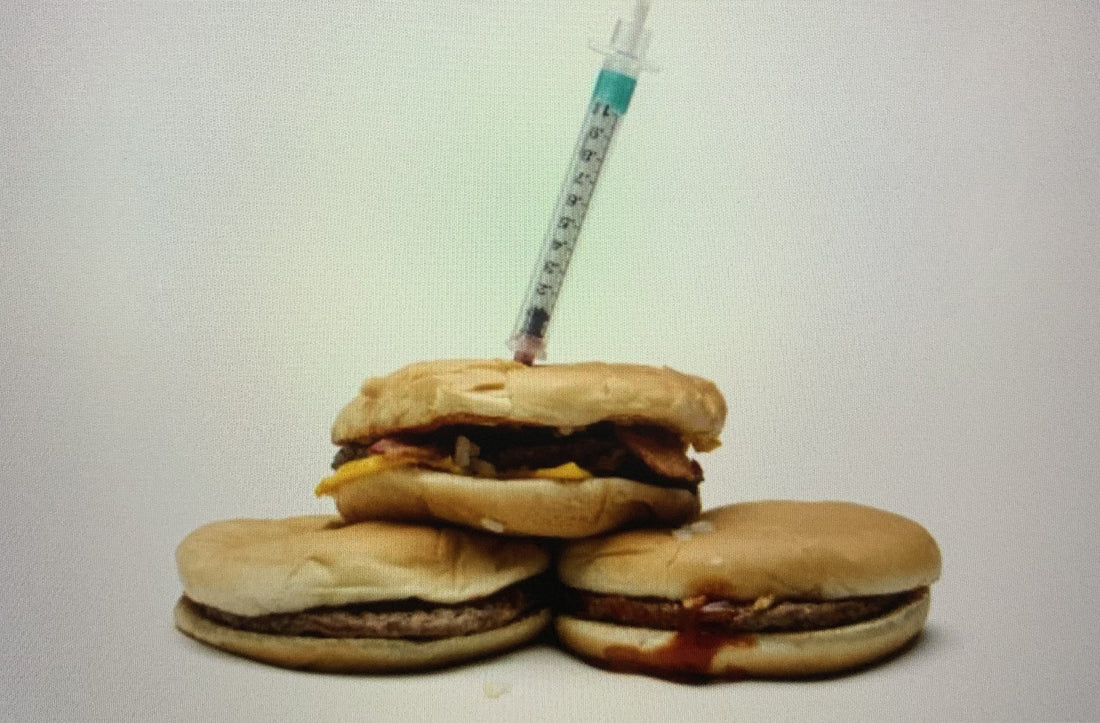Our Food: Antibiotics In Meat Pose A ‘Serious Public Health Threat’ Says FDA
Food is one of the great joys in life, but not if it’s harmful to our children, our health , longevity and the planet.
On average every America consumes nearly 200 pounds of meat each year, the average Brit 80kg ( 176 pounds). Most of this meat comes from Factory Farming, an industrial meat-producing system plagued with a variety of problems.
So what’s the problem?
For over 50 years, the animals, both sick and healthy, have been given regular sub-therapeutic doses of antibiotics mixed into their feed to kill pathogens, prevent disease and make their animals grow faster.
These animals eventually end on our dinner plates.
The reason that this is such a serious issue is that because the drugs create antibiotic-resistant bacteria that can infect humans who eat it The FDA says. Now it seems that the burgers, steaks and canned meats that we eat are harboring all sorts of bugs that antibiotics can not kill.
FDA: "Antibiotics in meat reared under Factory Farming conditions now pose a serious public health threat to humans".
by Annie Price, CHHC
When you order a burger at many of the most popular chains in the country, chances are you’re getting more than beef and a bun. According to a newly released report from a coalition of America’s leading food and environmental organizations including the Center for Food Safety, antibiotics are a major issue when it comes to mainstream beef.
The analysis, titled Chain Reaction IV: Burger Edition, is a must-see report that rates burger chains around the country on the quality of their beef; specifically when it comes to the use of antibiotics.
You may already be familiar with some of the insane things antibiotics can do to your body. And one of the biggest concerns of overexposure to antibiotics is something called antibiotic resistance, which occurs when an antibiotic can no longer effectively control or kill bacterial growth in the body. According to the Centers for Disease Control and Prevention (CDC), at least two million people are infected with antibiotic-resistant bacteria annually, and at least 23,000 people die as a result.
Meanwhile, the World Health Organization (WHO) calls antibiotic resistance one of the biggest threats to global health, food security, and development today. The WHO also points out that serious infections like pneumonia, tuberculosis, and salmonella are now becoming challenging to treat. In general, mortality rates due to antibiotic resistance are continuing to rise around the world. These are some scary facts, to say the least.
When it comes to antibiotic use in beef, let”s take a closer look at how the top 25 burger chains in the United States are rating these days. Spoiler alert: the majority are not just rating poorly; they’re completely failing.
Main Scorecard Findings
The grades from the Center for Food Safety show how each fast food chain scored in terms of its beef quality, specifically when it comes to antibiotic use:
BurgerFi: A
- One of only two chains on the list that sources beef that has been raised without the routine use of antibiotics.
- BurgerFi says that they use “100 percent all-natural Angus beef patties that are hormone- and antibiotic-free.”
Shake Shack: A
- Like BurgerFi, Shake Shack publicly declares it uses beef that was raised without routine antibiotic use.
- Shake Shack notes that its proprietary blend of freshly ground beef is “100 percent Angus beef, made from premium whole muscle cuts — no hormones or antibiotics, EVER.”
Wendy’s: D-
- Wendy’s currently sources 15 percent of its beef from producers that have stopped using one medically important antibiotic called tylosin by 20 percent.
McDonald’s: F
Burger King: F
Sonic: F
Jack in the Box: F
Hardee’s: F
Whataburger: F
Carl’s Jr: F
Five Guys: F
Culver’s: F
Steak ‘n Shake: F
In-N-Out Burger: F
White Castle: F
Checkers: F
Crystal: F
Smashburger: F
Freddy’s Frozen Custard & Steakburgers: F
The Habit Burger Grill: F
Rally’s: F
Fuddruckers: F
A&W All American Food: F
Jack’s: F
Farmer Boys: F
So out of 25 chains, two scored an “A,” one scored a “D-” and the rest of the burger chains received a completely failing grade. Why the “F” for these 22 beef sellers? According to the Center for Food Safety, these chains have no meaningful public policies on the use of antibiotics in their beef. In other words, none of them are claiming to source beef from cows raised without regular antibiotic use.
Side Effects of Antibiotics in Beef
A previous Chain Reaction II report focused on the use of antibiotic use in fast food. So why the focus on just beef for this report? According to the Center for Food Safety, “Although there is some progress in the chicken industry in response to such consumer demand, many fast food restaurants have failed to make meaningful commitments to address antibiotic overuse in their beef supply chains.” The Center also points out how in 2016, 43 percent of the “medically important antibiotics” sold to the meat industry was going to the beef sector, while six percent went to chicken.
Warnings over antibiotics overuse in animals raised for meat, eggs, and milk is nothing new. (We’ve also been hearing about the dangers of overusing antibiotics in hospitals and at home for some time, too.) But it’s especially important to focus on how industrial farming abuses antibiotics. Many cows receive frequent antibiotics not only to prevent infections in sub-par living conditions but to enable faster growth with less food. That’s right. Antibiotics are considered “obesogens,” a substance that promotes weight gain. In the industrial farming system, it’s a cheap way to fatten up cattle faster, increasing profit margins.
Regardless of the reasons behind the use of antibiotics, we’re running into a serious problem — animals overexposed to antibiotics end up with infections that drugs can’t fight. And those hard-to-kill superbugs can end up on your plate. Another threat? Certain antibiotics can trigger deadly reactions in people.
A recent Consumer Reports investigation found chloramphenicol in meat samples. According to the report: “This antibiotic, at any exposure level, can trigger life-threatening aplastic anemia, or the inability to produce enough new blood cells, in 1 in 10,000 people.”
About 80 percent of antibiotics used in the United States are fed to animals raised for food. And the majority is given to animals in chronic, low-doses to speed growth and prevent disease. This long-term exposure gives bacteria time to adapt to survive, rendering the antibiotics useless. Giving prolonged, low-dose antibiotics to farm animals is the perfect breeding ground for creating dangerous, drug-resistant germs.
In fact, just this year, University of Exeter researchers discovered that using antibiotics longer than needed creates a tipping point where germs become resistant to their effects. This new research suggests that reducing the length of the antibiotic course helps lower the risk of resistance. And when it comes to factory farms, this is definitely not what is going on. On these types of industrial farms, animals are generally given drugs even when they’re not ill.
Epidemiologists have clearly linked the excessive use of antibiotics in farm animals to infections detected in humans. For example, scientists detected an infection called methicillin-resistant Staphylococcus aureus (MRSA) in beef, turkey, chicken, and pork. MRSA is a bacteria that contribute to infections of the skin, connective tissue, and sometimes bones, heart and blood vessels. Since MRSA is resistant to many antibiotic medications, it can sometimes continue to spread throughout the body as bacteria make their way through the bloodstream and into pockets where they can quickly reproduce leading to pneumonia, sepsis and bloodstream infections. Exposure to another type of bacteria, E.coli, in animals is associated to sepsis as well as urinary tract infections in humans.
The use of antibiotics in beef is also having an extremely negative impact on the environment. When farm animals are given antibiotics, this leads to contamination of manure, soil, and water. When this contaminated manure and soil is used for growing plant-based food, the antibiotic chain continues. For example, crops like corn, potatoes, and lettuce have all tested positive for the antibiotic sulfamethazine in plant tissue.
Meat Quality and Quantity
According to a 2018 analysis by the Environmental Working Group (EWG), more than 47,000 federal government lab tests of bacteria in supermarket meat found a rise in the already high number of ground beef contaminated with antibiotic-resistant bacteria. So the concern is clearly not just about antibiotics in beef used for fast food hamburgers, but about the quality of the beef, we’re consuming in general.
One of the best ways to avoid antibiotics in beef is to look for brands that are certified USDA organic. According to the U.S. Department of Agriculture, this means that the beef comes from animals “raised in living conditions accommodating their natural behaviors (like the ability to graze on pasture), fed 100% organic feed and forage, and not administered antibiotics or hormones.” Choosing grass-fed beef is another criteria that increase the quality of your meat including its beneficial nutrients, but grass-fed cattle has also been shown to be better for the environment with a smaller carbon footprint.
Even if you’re following a high protein style of eating, like the ketogenic diet, don’t forget there are other healthy vegetarian sources of protein like nuts, beans, and lentils. In terms of the environment, these plant proteins are much less taxing. As the EWG points out, “If everyone in the U.S. skipped meat and cheese just one day a week and replaced them with a vegetable-based protein, it would be like not driving 91 billion miles, or taking 7.6 million cars off the road.”
Final Thoughts
- The use of antibiotics in beef (and other meats) is a major contributor to a serious health concern we are all facing around the globe today: antibiotic resistance.
- Meat producers and sellers of meat products (like the classic hamburger) need to start taking measures to supply us with beef that is ideally free of hazardous antibiotics.
- We also have to start demanding better ourselves and making a statement by choosing better quality meat at restaurants and in the grocery store.
- Giving excessive quantities of antibiotics to cows is not only harmful to their health, but it’s also contributing to major and even deadly infections in humans including MRSA, sepsis, and pneumonia.
- The use of antibiotics in beef is terrible for the environment. Avoiding burgers and other beef products sold by companies that show zero concern for the quality of their meat is a major way to fight back against the scary use of antibiotics in beef.
Team-
Looking Vibrant

